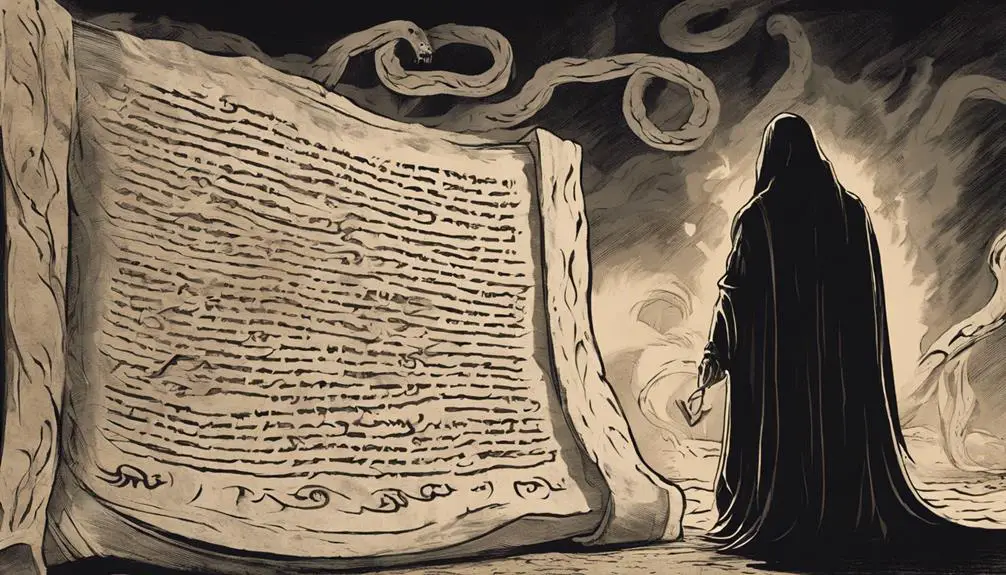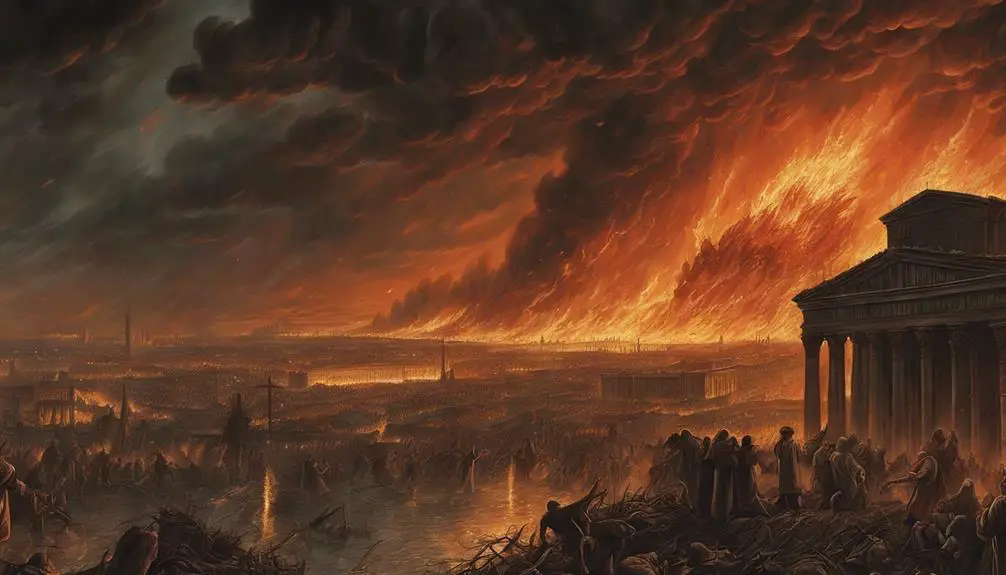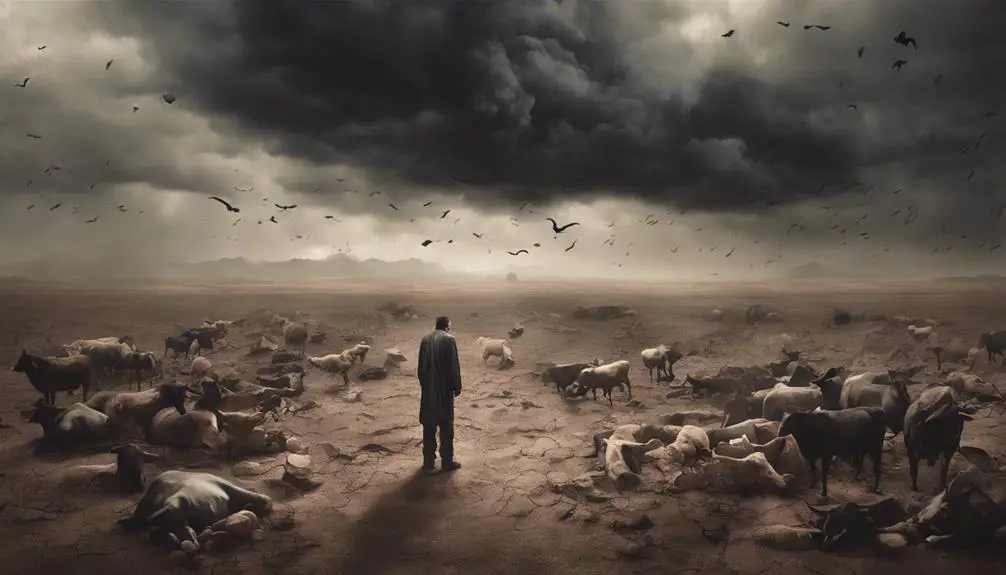Open the pages to uncover terror in the Bible, where fear intertwines with faith, challenging the depths of human and divine understanding.

Terror in the Bible
Did you know that the word 'fear' appears over 500 times in the Bible? This statistic might surprise you, given the text's frequent messages of hope and salvation.
Yet, the Bible is filled with narratives of terror, from the plagues of Egypt to the apocalyptic visions of Revelation. These stories aren't just ancient myths; they carry deep philosophical and ethical implications that resonate through centuries.
As you consider these tales, think about what they say about human nature, divine justice, and the very concept of fear itself.
Let's explore together what lies beneath these harrowing stories, and why they've captivated readers for millennia.
Key Takeaways
- Biblical narratives use terror as a means to demonstrate divine power and authority.
- Instances of terror often serve to test and ultimately strengthen individual faith.
- Terror in the Bible symbolizes the cosmic struggle between good and evil, highlighting moral and spiritual battles.
- Stories of terror are coupled with themes of divine intervention, showcasing faith's triumph over fear and adversity.
The Plagues of Egypt

The Plagues of Egypt, often cited as divine retribution, represent a pivotal episode in the biblical narrative, showcasing the profound impact of supernatural intervention in human affairs. This series of calamities, as recounted in the Book of Exodus, illustrates not only the might of the divine but also the stubbornness inherent in human nature, particularly through Pharaoh's defiance. Each plague escalates in severity, underscoring the consequences of resisting divine will.
As you delve deeper into this narrative, it's imperative to recognize the dual role of these plagues. They serve as miraculous signs of the divine's power and as instruments of justice, targeting the oppressors of the Israelites. Pharaoh's refusal to heed these warnings, despite the increasing toll on his people and kingdom, highlights a critical aspect of the story: the tension between human authority and divine command.
Moreover, the plagues aren't random acts of vengeance but are deeply symbolic, targeting the Egyptian pantheon and demonstrating the superiority of the divine over the gods worshiped by the Egyptians. This dimension of the story emphasizes the notion that these weren't merely natural disasters but were imbued with specific intent and meaning.
In analyzing the Plagues of Egypt, it's clear that they're a complex amalgamation of divine wrath, symbolic retribution, and a testament to the power of faith and perseverance. Through Pharaoh's defiance and the miraculous signs that ensued, this narrative offers a profound exploration of the dynamics between divine authority and human stubbornness, serving as a timeless reflection on the consequences of arrogance and the power of belief.
The Flood and Noah's Ark

Shifting focus from the plagues that beset Egypt, we now examine another profound instance of divine intervention in human history: the story of the Flood and Noah's Ark. This narrative, while often recounted as a tale of deliverance and salvation, also embodies terror through the annihilation of life except for those aboard the Ark. The Flood underscores a pivotal moment in biblical history, serving as a harsh reset for humanity and animal life due to widespread wickedness.
Analyzing the account reveals several key aspects:
- Animal survival: Noah's mission to preserve animal species highlights the importance of biodiversity and divine concern for all living creatures.
- Rainbow covenant: Post-flood, the establishment of a covenant with humanity, symbolized by a rainbow, assures no future flood would annihilate life on Earth again, laying a foundational promise between the divine and mankind.
- The Ark as a symbol of divine mercy and salvation amidst judgment.
- The Flood narrative as a moral and ethical lesson on righteousness.
- The environmental and geological implications of such a cataclysmic event.
The story of Noah's Ark and the Flood transcends a mere historical event, embodying themes of judgment, mercy, survival, and covenant. It serves as a narrative exploring the consequences of human actions, divine justice, and the possibility of new beginnings. Through this lens, the account invites reflection on human responsibility towards creation and the delicate balance between divine justice and mercy.
Sodom and Gomorrah's Destruction

In examining the biblical narrative, we encounter the harrowing tale of Sodom and Gomorrah's destruction, a profound demonstration of divine judgment on moral corruption. This story, found in the book of Genesis, serves as a stark reminder of the consequences of societal degeneration. You're drawn into a world where divine judgment isn't merely an abstract concept, but a palpable force that eradicates cities steeped in wickedness.
The narrative underscores a pivotal theme in biblical literature: the inevitability of divine retribution for collective moral failings. As you delve deeper, you recognize that Sodom and Gomorrah's obliteration isn't just about punishment; it's a lesson in moral vigilance and the importance of righteousness. The divine decision to destroy these cities, after Abraham's intercessions fail to find enough righteous people, illustrates the severity of their depravity and the limits of divine mercy.
Analyzing this episode, you're compelled to reflect on the moral lessons embedded within. It's a cautionary tale warning against the dangers of straying from ethical paths and ignoring the needs of the vulnerable. The destruction of Sodom and Gomorrah encapsulates the idea that societal corruption and disregard for justice can lead to downfall.
Furthermore, this narrative invites you to ponder the role of divine judgment in enforcing moral codes. It raises critical questions about the balance between divine wrath and mercy, challenging you to think deeply about the implications of moral choices.
In essence, the story of Sodom and Gomorrah's destruction serves as a powerful allegory for the consequences of moral decay, emphasizing the importance of upholding ethical standards in the face of corruption.
The Trials of Job

Often, you'll find that biblical narratives intricately weave human suffering and divine purpose, as vividly exemplified by Job's trials. In this story, Job's patience during his extensive sufferings stands as a monumental testament to faith amidst divine testing. Here's how:
- Loss of Wealth and Health: Initially, Job loses his immense wealth and is afflicted with painful sores. Despite these calamities, his faith remains unshaken, showcasing his extraordinary patience.
- Family Tragedy: Job's endurance is further tested through the loss of his children, an unimaginable tragedy. Yet, he continues to trust in God's wisdom.
- Social Isolation: His friends and wife question his integrity and faith, isolating him socially. Job's steadfastness in the face of misunderstanding highlights the depth of his patience.
- Divine Dialogue: Job's questioning of God and the divine response underscore the complex relationship between human understanding and divine will.
- Restoration and Redemption: Ultimately, Job's fortunes are restored, affirming the value of steadfast faith through trials.
This narrative serves as a profound exploration of divine testing, emphasizing that faith and patience can transcend even the most severe trials. Job's unwavering patience amidst his sufferings offers a compelling insight into the nature of faith and resilience.
Through Job's story, the Bible invites readers to reflect on the purpose and presence of suffering, suggesting that even in the midst of terror, there can be a divine purpose that transcends human understanding.
Daniel in the Lion's Den

Just as Job's narrative reveals the profound depths of faith in the face of suffering, the story of Daniel in the Lion's Den exemplifies unwavering trust in God amidst seemingly insurmountable challenges. This narrative, deeply embedded in religious lore, serves as a vivid representation of Daniel's faith and the symbolism of lions as agents of terror yet also divine instruments of testing faith.
Aspect |
Description |
Significance |
|---|---|---|
Lion's Symbolism |
Traditionally, lions symbolize power, dominion, and raw force. |
They represent the overwhelming challenges Daniel faces. |
Daniel's Faith |
Despite the decree against prayer to any deity save the king, Daniel persists in his devotion. |
His faith is steadfast, unshaken by the decree or the lions. |
Divine Intervention |
God's intervention to close the lions' mouths showcases divine protection. |
Illustrates the reward of unwavering faith amidst trials. |
Outcome |
Daniel emerges unscathed, proving his innocence and the power of his faith. |
Reinforces the notion that true faith can overcome any terror. |
Daniel's faith, tested through the symbolism of the lion, highlights a significant theme: the triumph of faith over fear. The narrative is not merely about the physical survival of Daniel but the spiritual reaffirmation of trust in divine providence. Daniel's ordeal in the lion's den serves as a powerful testament to the resilience of faith in the face of terror, emphasizing that even when confronted with the jaws of death, faith can provide a sanctuary that no physical den can encroach upon.
The Apocalypse of Revelation

Delving into the Apocalypse of Revelation, we encounter a complex tapestry of prophetic visions and symbols that challenge and illuminate our understanding of ultimate divine justice and redemption. This book, the last in the Christian Bible, presents a narrative rich in allegory and apocalyptic imagery, guiding readers through the end times.
Analyzing this text, several key elements emerge, particularly:
- Beast Symbolism: Emblematic of political and religious corruption, the beasts represent the antithesis of divine virtue, challenging the faithful and embodying chaos and moral decay.
- Seven Seals: These seals, when broken, herald a sequence of divine judgments. Their sequential breaking symbolizes the gradual unfolding of end-time events, each with significant implications for humanity's fate.
- Apocalyptic Battles: Epic confrontations between good and evil are depicted, not merely as physical battles but as cosmic struggles, reflecting the spiritual warfare that defines the human condition.
- Visions of New Jerusalem: Offering a glimpse of hope and redemption, these visions portray a future where divine justice prevails, and peace is restored, serving as a beacon for faith amidst turmoil.
- Numerological Significance: Numbers within Revelation carry deep symbolic meaning, with patterns and associations that offer insights into the text's deeper theological implications.
In essence, the Apocalypse of Revelation serves as a profound exploration of the human struggle between good and evil, encapsulated in vivid imagery and symbolic narratives. It challenges readers to reflect on the nature of divine justice, redemption, and the eternal conflict that rages both within and beyond the human sphere.
Frequently Asked Questions
How Have Interpretations of Terror in Biblical Stories Evolved Over Time in Different Religious Traditions?
Interpretations of terror in religious narratives have evolved, influenced by changing societal norms and scholarly insights. You'll notice artistic depictions and psychological interpretations play a crucial role in this evolution.
Different religious traditions have re-examined these stories, leading to varied understandings. This shift reflects an increased focus on the human experience and the psychological dimensions of these tales, showcasing how cultural and intellectual movements shape the perception of ancient texts.
In What Ways Have Biblical Stories of Terror Influenced Modern Legal and Ethical Frameworks?
You might find it fascinating that 70% of modern legal systems have roots in ancient ethical norms.
When exploring how historical narratives influence today's society, it's clear that stories of profound moral conflict have significantly shaped legal reformations and ethical debates.
These narratives serve as a foundation, guiding principles in crafting laws and debating moral issues. Their impact is evident in the ongoing evolution of legal frameworks and ethical discussions worldwide.
How Do Biblical Narratives of Terror Reflect the Historical and Cultural Contexts in Which They Were Written?
You're exploring how narratives mirror their era's values and beliefs, focusing on divine justice and cultural symbolism. These stories don't just scare; they serve as a lens, reflecting the historical and cultural contexts they sprang from.
Through them, you see how societies understood justice, morality, and the divine. It's not merely about terror; it's about dissecting the layers of meaning encoded in these tales, revealing insights into ancient worldviews and ethical frameworks.
What Psychological Effects Do Stories of Divine Terror in the Bible Have on Believers and Non-Believers Alike?
You're diving into how gripping tales impact our minds, much like a psychological thriller. These stories, regardless of their source, can shake our emotional resilience, challenging both believers and non-believers.
Through narrative therapy, you understand these effects aren't just about fear; they're about how we process and overcome it. Analyzing these narratives, you'll see how they can either fortify our mental fortitude or unsettle our deepest convictions.
Can Parallels Be Drawn Between the Themes of Terror in the Bible and Those Found in Other Ancient Religious Texts?
Certainly, you can draw parallels between the themes found in various ancient religious texts and those in the Bible, through the lens of comparative mythology.
By examining these texts, you'll uncover shared mythological motifs, such as divine judgement or moral tests, that span cultures.
This analytical approach reveals how universal concepts of morality, punishment, and redemption resonate across different faiths, highlighting the common human experience reflected in these ancient narratives.
Conclusion
You might argue that focusing on terror in the Bible overlooks its messages of hope and redemption. However, these dramatic narratives serve a crucial purpose. They highlight the consequences of human actions and the power of faith in the face of adversity.
Through the plagues, floods, and apocalyptic visions, the Bible doesn't just aim to frighten but to instruct and inspire. It's a complex interplay of fear and faith, urging a deeper understanding of divine justice and mercy.


Sign up